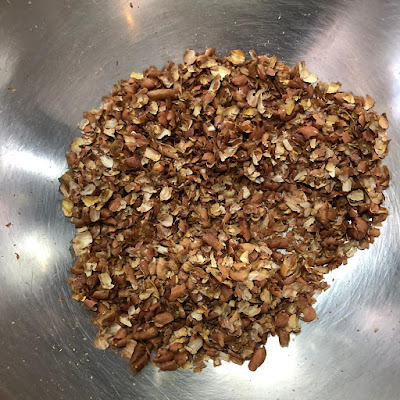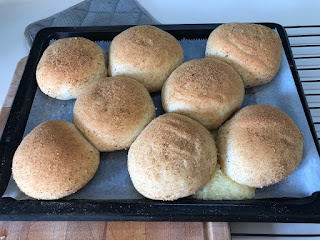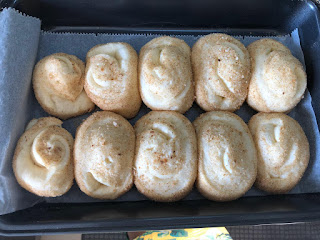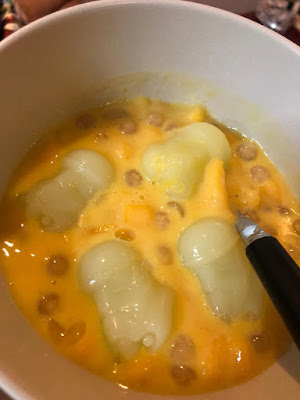It's the 6th day of Circuit Breaker here in Singapore and 29 days since the lockdown in Manila. With a lot of time in their hands, people have been cooking and baking. Im one of them.
The idea came after seeing saba or plantain bananas in the market. Those bananas are not easily found in supermarkets but they're almost always available in Chong Pang. I dont like the cavendish variety. Too sweet for me.
 |
| Saba |
Binallay or ginataang bilo-bilo is one of the most common meryenda back home. Growing up in a farming community, rice is of prime importance. Almost every household would have it. For rice farmers, glutinous rice is a premium. And this is the main ingredient in this dish.
In our small farm, I remember that we would always have one of the plots reserved for planting glutinous rice. The grains are round compared to the regular rice. My parents never sold them. It was always reserved for consumption or gifting to relatives. Oddly enough, we didn't cook a lot of binallay at home. I think it's because it takes a lot of time to cook.
The food is staple during wakes. For celebrations, it is staple for households who cant afford to buy pansit. It's understandable. The ingredients are cheap and at certain times, free. The most important ingredients are ground glutinous rice, mature coconut, and sugar.
1. The glutinous rice can be sourced from your own farm or a present from a neighbor although it became more commercialized when I was a teenager.
2. Almost everyone has a coconut tree in their backyard. If you dont have one, you can walk around to survey which household has a mature coconut tree and ask for that. Usually people do not mind. You can just give a portion of the cooked binallay once you're done. Or just give you can share other stuff from your backyard to that same neighbor later on like a bunch of moringa leaves, freshly picked sweet potato leaves, or even rice. People give and take.
Once you've spotted your coconut, the next to look for is a group of kids whom you could ask to climb the tree for you. Usually, they would. It's like a game for them. When you get home, you could grate the coconut yourself. I was tasked to do the job once in a while although it's Uncle Doming who would always do it when he was around.
Aside from the bilo bilo, the other ingredients are optional. Again, these are easy to find crops. Bananas. Sweet potatoes. Arrow roots. Cassava. You can put whatever you want. Just chop them into small pieces and you're good to go.
 |
| Binallay ingredients. The pandan is from our corridor garden |
 |
| Sago. Cook it separately from the rest of the ingredients |
 |
| Sweet potatoes. You can mix different colors for a more vibrant-looking binallay |
 |
| Langka. Aside from the sweetness, it gives a nice fragrance to the dish |
 |
| Cassava |
The most enjoyable part of cooking this disk is preparing the bilo bilo. Usually a group of people would prepare it. It's a social activity. People will be chatting while working making the job easier. During special occasions, or sad ones such as wakes, it's mostly women who would gather around a basin filled with the galapong or dough. In our community, the dough is rolled into sausage-like rolls and cut into small pieces. From there, you round it in your palm to make balls. It's easier than taking one small pinch at a time.
 |
| Roll the dough and cut into small pieces |
 |
| Then roll them into balls |
 |
| Voila! Bilo bilo! Sprinkle ground rice so that they don't stick together |
Cooking is easy. Just boil water and coconut milk with pandan. Put a pinch of salt and sugar. The salt gives a more complex flavour to the dish. The sugar sweetens the soup base and sweetness depends on your taste. The pandan is responsible for the sweet aroma of the dish.
 |
| Boil boil boil |
Once it boils, you can put your other ingredients. The sequence follows a simple logic - hard ones first (sweet potatoes, cassava) and once they're soft, mix the softer ones next (banana, jackfruit). The last to go into the pot is the bilo bilo.
Just keep mixing. You'll know the bilo bilo is ready once they float.
 |
| Bilo-bilo floats when it's ready |
That's it. You have your binallay or ginataang bilo bilo.
 |
Cooked binallay or ginataang bilo bilo
Fun fact: I learned that binallay in Isabela is suman and not the ginataang bilo bilo which the Ibanags in Aparri refer to. |
This post is inspired by Dave Chang's Ugly Delicious series where he delves into the history and culture of the dish featured in each episode.

















































